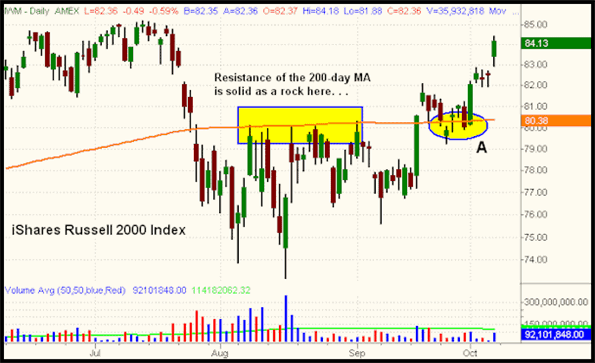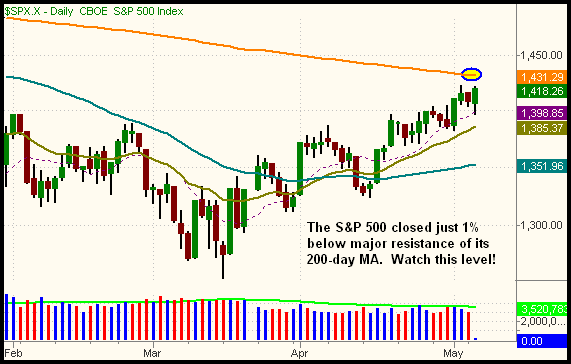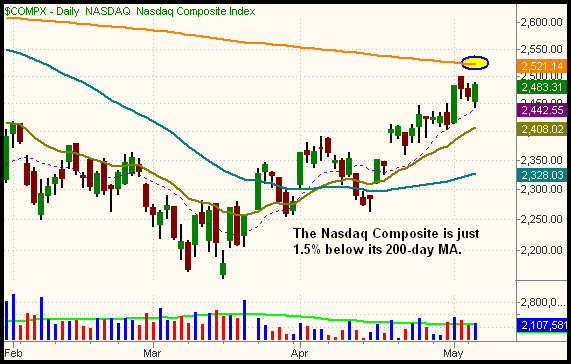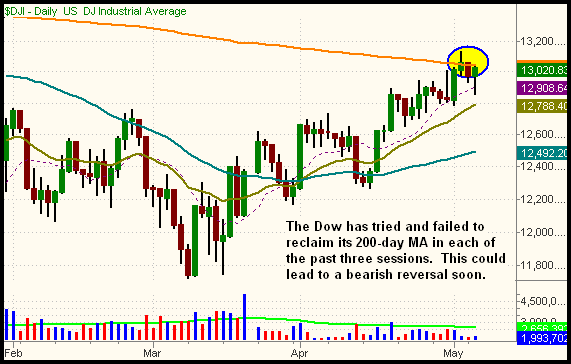| The Wagner Daily ETF Report For May 7 |
| By Deron Wagner |
Published
05/7/2008
|
Stocks
|
Unrated
|
|
|
|
The Wagner Daily ETF Report For May 7
Stocks got off to a rough start yesterday morning, but recovered to finish the day solidly higher. Although the major indices opened significantly lower and dropped a bit more in the first thirty minutes, the bulls subsequently stepped up to the plate and triggered a steady intraday uptrend in the broad market. The S&P 500, Nasdaq Composite, small-cap Russell 2000, and S&P Midcap 400 each scored an identical gain of 0.8%. The black sheep was the Dow Jones Industrial Average, which climbed 0.4%. All the major indices closed near their best levels of the day.
Total volume in the NYSE rose 11%, while volume in the Nasdaq ticked 4% above the previous day's level. The gains on higher volume technically enabled both the S&P 500 and Nasdaq Composite to register a bullish "accumulation day." However, it should be noted that much of the volume increase occurred as stocks were selling off in the morning. Market internals were firm. Advancing volume in the NYSE exceeded declining volume by a margin of 2 to 1. The Nasdaq ratio was positive by 3 to 1.
When analyzing intraday, daily, and weekly charts, the moving averages we most commonly discuss are the 20-day and 50-day MAs. The 20-day MA shows the price trend in the short-term and the 50-day MA shows the overall bias in the intermediate-term. More important than both of these moving averages, but less frequently discussed, is the 200-day MA, which shows the long-term trend of the market.
In technical analysis, the longer the time interval of a chart, the more bearing and weight the pattern will have on the direction of the market than the shorter time frame. The same is true of moving averages. A 50-day MA is more difficult to break through than a 20-day MA, while a 200-day MA holds more weight than a 50-day MA. Many institutions utilize program trading to automatically begin buying when stocks or ETFs retrace to support of their 50-day MAs, or sell positions when they rally into resistance of their 50-day MAs. This is even more the case with the 200-day MA, as it is considered to be a gauge of the overall market's "big picture" health.
It's a rather amazing concept, but the 200-day MA simply acts like a brick wall whenever a stock, ETF, or index runs into it. It doesn't matter whether it's a test of support from above or rally into resistance from below. Either way, a position will rarely move through the 200-day MA on the initial test. Unless the dominant trend is really strong, it will generally require multiple tests of the 200-day MA before an equity or stock market index eventually busts through. This is not only with the 200-day moving averages on the daily charts, but on the intraday and long-term weekly charts as well. A great example of the power of the 200-day moving average can be seen on the daily chart of the iShares Russell 2000 (IWM) below, taken from mid-2007. The shorter-term 20 and 50-day moving averages have been removed so you can more easily see the 200-day MA:

Isn't it fascinating how the 200-day MA perfectly acted like a brick wall on every rally attempt in IWM until it finally popped above it in mid-September? After it broke out above the 200-day MA, the prior resistance of the 200-day MA became the new support level. The most basic tenet of technical analysis is that a prior area of resistance will become the new support after the resistance is broken. The chart above is a great example of this. At the letter "A," you see that the 200-day MA became the new support.
The reason for this discussion on the 200-day MA is that both the S&P 500 and Nasdaq Composite will soon test resistance of their 200-day MAs for the first time this year. As history has proven, the 200-day MAs could be the turning point that causes the main stock market indexes to resume their primary downtrends that have been in place since last October. The S&P 500 closed just 1% below its 200-day yesterday, while the Nasdaq Composite is only 1.5% away from its 200-day MA. The 200-day MAs are shown on the daily charts of the S&P and Nasdaq below:


Leading the "big three" stock market indexes, the Dow Jones Industrial Average has already run into resistance of its 200-day MA. In each of the past three sessions, the Dow tried and failed to move above its 200-day MA. If the Dow is unable to reclaim its 200-day MA in the near future, the bullish momentum we've been seeing could quickly turn into major selling pressure, at least in the short-term. Take a look:

We remain only lightly positioned in the market right now. We're still monitoring the iShares Nasdaq Biotech (IBB) for a potential breakout above its recent range and 200-day MA, but that has not happened yet. A pullback to support in the Market Vectors Steel (SLX) would also present a relatively low-risk buy entry. As for the short side, there's no reason to consider any entries unless the main stock market indexes fall below yesterday's intraday lows. Such a sell-off would cause a breakdown below both the hourly uptrend lines and 10-day MAs, thereby triggering ideal short entries with positive reward/risk ratios.
Open ETF positions:
Long - UUP
Short - (none)
Deron Wagner is the Founder and Head Trader of both Morpheus Capital LP, a U.S. hedge fund, and Morpheus Trading Group, a trader education firm launched in 2001 that provides daily technical analysis of the leading ETFs and stocks. For a free trial to the full version of The Wagner Daily or to learn about Wagner's other services, visit MorpheusTrading.com or send an e-mail to deron@morpheustrading.com.
|